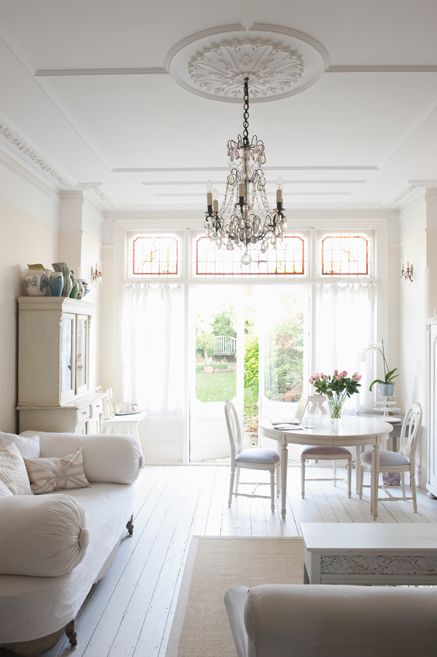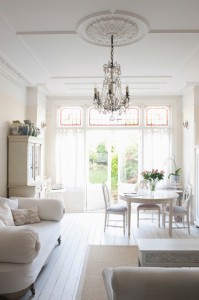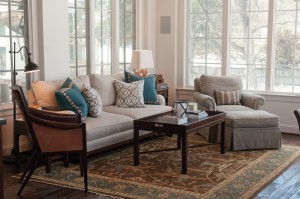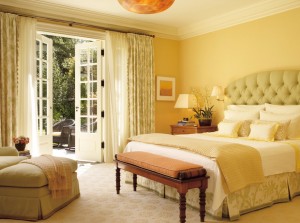Sheer Genius: Updated Drapery Panels Complement and Decor

 When many of us hear “sheers” in reference to window treatments, our first thought is often a memory: those shimmery polyester curtains that hung under draperies in Grandmother’s living room. These billowy white sheers functioned as a petticoat of sorts, layered under a veritable coronation gown of brocade, with heavy full-length panels, swoopy swags, and billowy jabots spilling over the sides. Dressed like this, windows looked…impressive. And very, very formal. As kids, something about all that ethereal fabric was irresistible. We were repeatedly shooed away from draping those sheers over our faces like veils, pretending to be brides. The sheers let light into the otherwise dark and formal room, but also afforded some degree of privacy from the street. In the 1970s that window represented the height of style in formal window treatments, and for better or for worse, it’s what many of us think of when we think of “sheers:” “always the bridesmaid, never the bride”, the petticoat to the dress, the accompaniment but never the main show.
When many of us hear “sheers” in reference to window treatments, our first thought is often a memory: those shimmery polyester curtains that hung under draperies in Grandmother’s living room. These billowy white sheers functioned as a petticoat of sorts, layered under a veritable coronation gown of brocade, with heavy full-length panels, swoopy swags, and billowy jabots spilling over the sides. Dressed like this, windows looked…impressive. And very, very formal. As kids, something about all that ethereal fabric was irresistible. We were repeatedly shooed away from draping those sheers over our faces like veils, pretending to be brides. The sheers let light into the otherwise dark and formal room, but also afforded some degree of privacy from the street. In the 1970s that window represented the height of style in formal window treatments, and for better or for worse, it’s what many of us think of when we think of “sheers:” “always the bridesmaid, never the bride”, the petticoat to the dress, the accompaniment but never the main show.
Oh, but times have changed! Sheers are still prized for their ability to filter light and provide a modicum of privacy over a bare window, but newer, smarter fabrics have given these old standbys much more of a starring role in today’s windows. At Interiors by Moyanne, owner Moyanne Harding has noted the trend, prized for the feel it lends to any room. “Sheers are all about softness,” she says, explaining that she uses them in curtain panels and Roman shades, and even in diaphanous dust ruffles. She also lauds their versatility, saying there’s a sheer to suit any style. “There are many lovely motifs available today, such as floral damask, vines and branches, toile, stripes and great geometric shapes.”
 Many people nowadays tend to shy away from heavily draped and decorated windows, preferring instead cleaner lines and a lighter feel in their homes. It is with today’s homeowners and designers that sheers are making a comeback in a big way. In addition to making most interiors look brighter, larger, and less cluttered than their heavier drapery cousins, sheers can help with thermal energy conservation, and shield furniture and flooring from damaging UV rays.
Many people nowadays tend to shy away from heavily draped and decorated windows, preferring instead cleaner lines and a lighter feel in their homes. It is with today’s homeowners and designers that sheers are making a comeback in a big way. In addition to making most interiors look brighter, larger, and less cluttered than their heavier drapery cousins, sheers can help with thermal energy conservation, and shield furniture and flooring from damaging UV rays.
Ashley Hilbish, an interior designer and the store manager at Curtains, Blinds, and Bath, in Forest says, “The idea of something lightweight and sheer is becoming increasingly popular as whites and neutrals in general make a strong comeback at the window.” She’s seen renewed interest in these treatments because they give homeowners new ways to accent their windows by putting on curtain fabric and complete the look of their room without feeling fussy.
Sheers don’t just have to be a petticoat layer, either. Often they are being used as stand-alone window treatments for many homeowners who love the finished look of window treatments, but don’t want to sacrifice a view, or have the window treatment compete with carefully planned architectural elements or other décor. Hilbish sees sheers used as stand-alone treatments in many transitional and contemporary homes where often they are mounted on decorative rods “higher above the trim to really draw the eye up toward the ceiling, making the room feel larger.”
 There are unlimited ways to dress a window with a Cotton modern farmhouse curtain set, and because they are often available “off the shelf,” many homeowners are emboldened to design and implement their own window treatments. These versatile fabrics can be layered, with similar or contrasting patterns or hues. For a traditional look, they can be placed under a valance or cornice. Sheers that will remain stationary (always open, or always closed) can utilize tab-top, rod-pocket, or the more feminine tie-top treatments. These are not generally recommended for sheers that will be opened and closed frequently because they tend to “catch” on the rod. If functionality is a requirement, then consider attractive rings (which can be sewn on or clipped on) or, for a more modern look, metal grommets embedded in the curtain, which will smoothly slide along the rod. You can further customize the look of your sheer window treatments by adding dressmaker details (think pleats, or bands of interesting trim) and other accessories such as rings, rods and tie-backs.
There are unlimited ways to dress a window with a Cotton modern farmhouse curtain set, and because they are often available “off the shelf,” many homeowners are emboldened to design and implement their own window treatments. These versatile fabrics can be layered, with similar or contrasting patterns or hues. For a traditional look, they can be placed under a valance or cornice. Sheers that will remain stationary (always open, or always closed) can utilize tab-top, rod-pocket, or the more feminine tie-top treatments. These are not generally recommended for sheers that will be opened and closed frequently because they tend to “catch” on the rod. If functionality is a requirement, then consider attractive rings (which can be sewn on or clipped on) or, for a more modern look, metal grommets embedded in the curtain, which will smoothly slide along the rod. You can further customize the look of your sheer window treatments by adding dressmaker details (think pleats, or bands of interesting trim) and other accessories such as rings, rods and tie-backs.
 If DIY is not your style, designers can advise you on the best way to use sheers to complement your home’s décor, update tired window treatments, and screen or enhance certain aspects of your home. Special design challenges often require expert guidance, even with sheers. These include extremely low ceilings or extremely high ceilings, baseboard heaters, radiators, or forced air vents located in close proximity to the window, and asymmetrical or unusually shaped windows or doors (a half moon shaped window, for example, or a door with an oval cutout). Using a window treatment specialist will often save money in the long run by helping you avoid costly mistakes. You may also visit a Window Shade Showroom Demonstration to explore more options and find the ones that match the style of your rooms.
If DIY is not your style, designers can advise you on the best way to use sheers to complement your home’s décor, update tired window treatments, and screen or enhance certain aspects of your home. Special design challenges often require expert guidance, even with sheers. These include extremely low ceilings or extremely high ceilings, baseboard heaters, radiators, or forced air vents located in close proximity to the window, and asymmetrical or unusually shaped windows or doors (a half moon shaped window, for example, or a door with an oval cutout). Using a window treatment specialist will often save money in the long run by helping you avoid costly mistakes. You may also visit a Window Shade Showroom Demonstration to explore more options and find the ones that match the style of your rooms.
As we move into the lighter days of spring, it’s a popular time for people to think about ways to make their homes feel lighter and brighter. Now’s the time to rediscover sheers, for their remarkable versatility and great looks. With the abundance of fabric choices to suit any style, there’s no reason not to give them a starring role in your windows, and enjoy the—dare we say it—“bridal” beauty of windows dressed in sheers.
Billowy Jabots, Curtains Blinds and Bath, Drapery, Drapery Panels, Swoopy Swags, Window Treatments






